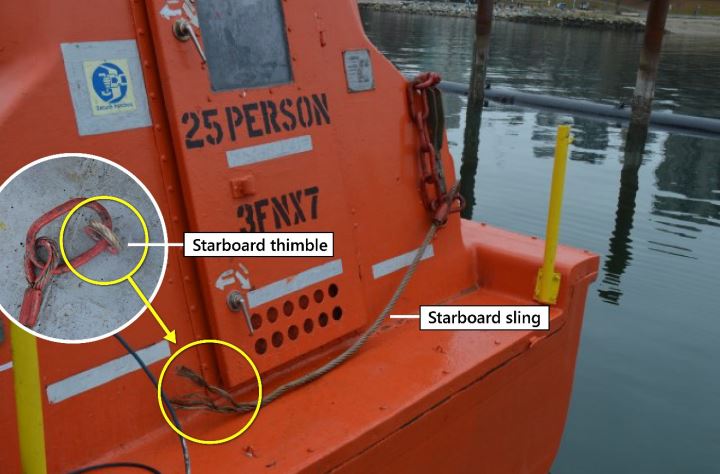
Experts investigating yet another lifeboat launching accident, in which two seafarers suffered serious injuries, have highlighted a worrying loophole in the international rules governing safety inspections of life-saving equipment.
Without action to tackle the issue – by introducing requirements for freefall lifeboat slings to be verified periodically, inspected before use and marked with a safe working load – 'there is a risk that this critical equipment will be overlooked during inspections or its safe limits will be exceeded, leading to an accident'.
The concerns are raised in a Transportation Safety Board of Canada (TSB) report on the accidental release of a freefall lifeboat during a drill onboard the Panama-flagged bulk carrier Blue Bosporus in December 2020.
Two crew members were taken to hospital for treatment on serious leg and hand injuries after the lifeboat fell 14m into the water when slings and a bracket on the lifeboat failed.
TSB investigators found that crimp sleeves which secured the eyes on the lifeboat slings had weakened over time and the way in which the slings had been attached to hooks on the lifeboat davit had caused the load to concentrate on the right rear sling. This resulted in sequential failure of the slings and the aft port sling bracket.
The report points out that the SOLAS Convention rules on the inspection and testing of lifeboats, liferafts, rescue boats and various assorted components do not specifically address freefall lifeboat slings.
The ship's maintenance routines and procedures did not cover checks on the condition of the slings, and although the lifeboat davit and launching appliances had undergone classification society-approved inspection and testing by a service company only one month before the accident, the checklist did not prompt a visual inspection of the slings and small cracks in the crimp sleeves were not spotted.
The TSB also noted that the ship's safety management system did not cover a complete procedure for conducting a drill that involved launching the lifeboat using the davit, and as a result of this the crew had developed an informal practice which failed to address the risk of standing unsecured in the lifeboat. While the owners had verbally told crew to conduct drills without crew inside the lifeboat when it was being lowered into the water with the davit, this guidance was not documented.
The report raises concerns that the impact of the Covid pandemic may have been another factor in the accident. Investigators referred to the 'relative inexperience' of the two injured seafarers, as well as the way in which the third officer's ability to effectively supervise them had been compromised by carrying out the work normally done by two other officers. The ship's owners had cut familiarisation periods in a bid to reduce the risks of Covid transmission between incoming and outgoing crews, the TSB noted, and this made it harder for new crew to absorb critical information.
Opportunities to identify safety risks associated with the drill had also been reduced because the third officer was having to 'multi-task' in the absence of two other officers.
Tags
More articles
Nautilus official joins talented new line up of trustees at The Seafarers' Charity
Nautilus International's executive director Martyn Gray has been made a trustee of of The Seafarers' Charity.
Nautilus gives evidence on Maritime 2050 to select committee
Nautilus International has submitted written evidence to the Transport Select Committee's inquiry into the implementation, objectives, and effects of the Maritime 2050 plan.
New diversity initiatives flagged at dedicated UK Pride month roundtable
Nautilus was represented at a special Pride month event during Maritime UK's third Pride in Maritime network and roundtable, which discussed upcoming maritime diversity initiatives
